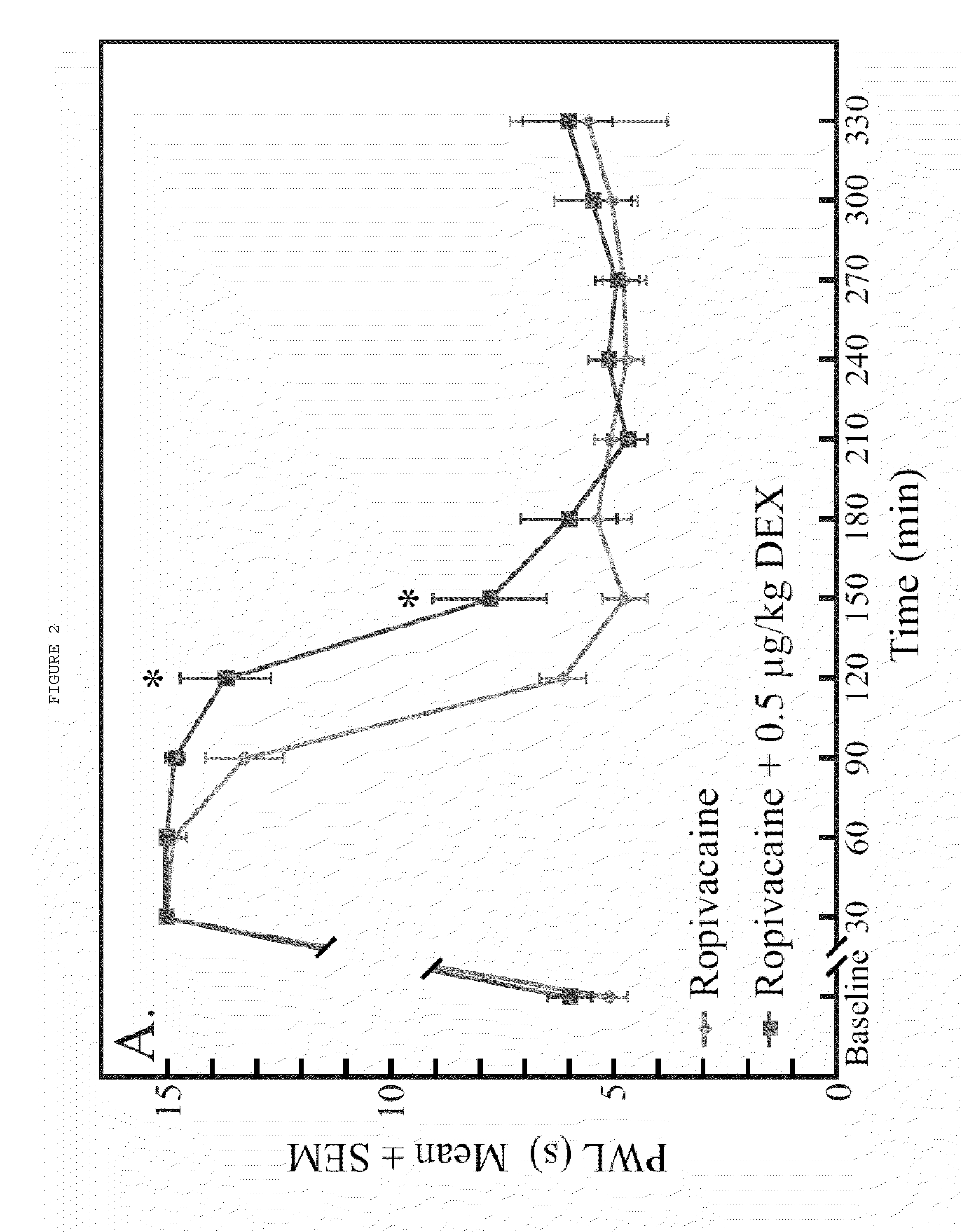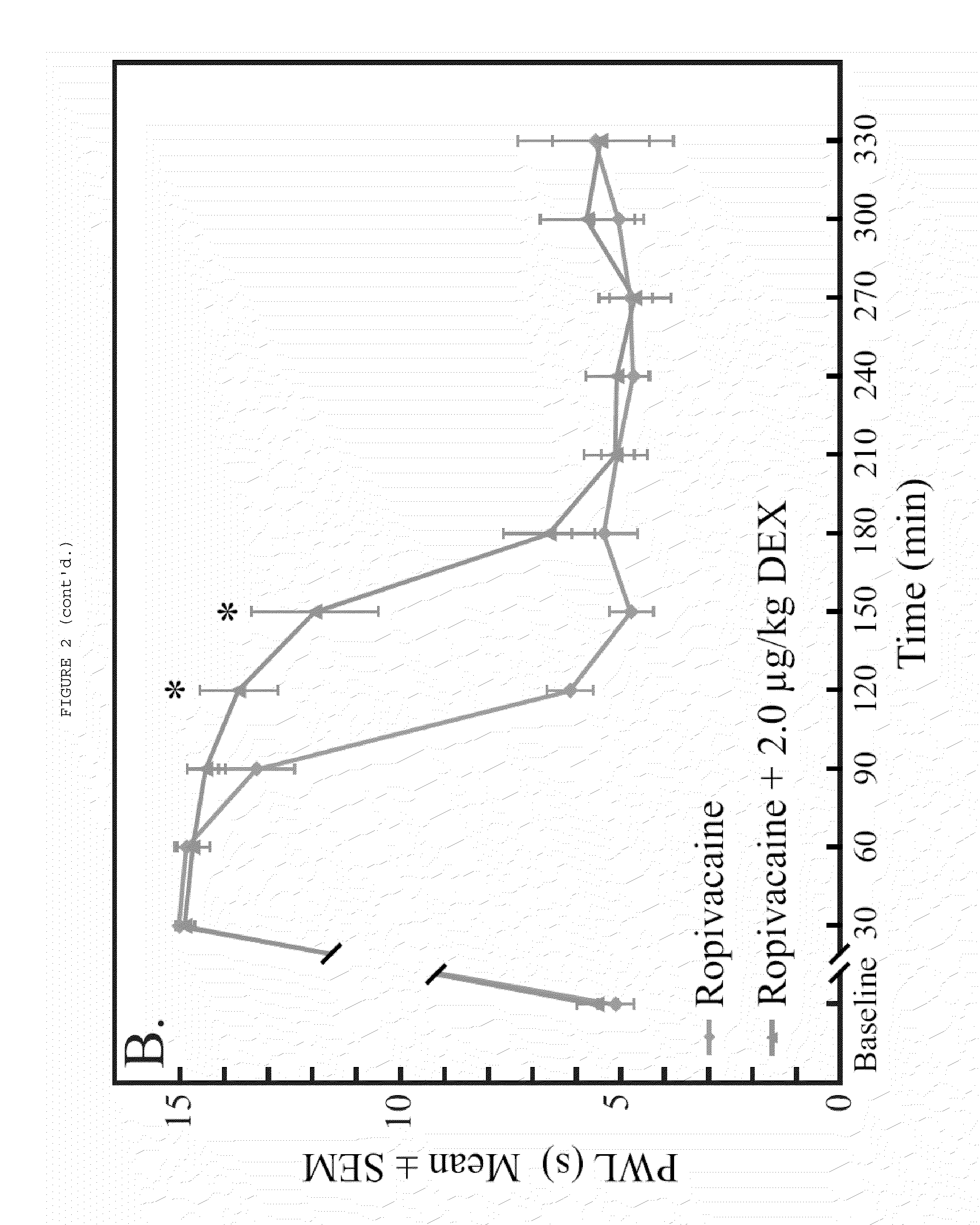Anesthetic methods and compositions
a technology applied in the field of compositions and anesthetics, can solve the problems of neurotoxicity, inability to predictably have the same systemic toxicity, neurotoxicity, effectiveness, etc., and achieve the effect of reducing pain in a subject, eliminating and reducing the toxicity of local anesthetics
- Summary
- Abstract
- Description
- Claims
- Application Information
AI Technical Summary
Benefits of technology
Problems solved by technology
Method used
Image
Examples
example 1
[0055]Methods described in Example 1 were employed in the course of experiments described in Example 2, and in Example 3 with modifications as indicated therein.
[0056]This study adhered to American Physiological Society and National Institutes of Health guidelines and was approved by the University of Michigan Committee for the Use and Care of Animals (Ann Arbor, Mich.). All procedures were conducted in accordance with the Guide for the Care and Use of Laboratory Animals and the Guidelines for the Care and Use of Mammals in Neuroscience and Behavioral Research.
Drug Preparation
[0057]Commercially available 0.75% ropivacaine solution was mixed with preservative free normal saline or dexmedetomidine to make final solutions. The control group received 0.5% ropivacaine alone. In the experimental groups, ropivacaine was mixed with dexmedetomidine to make solutions based on the individual rat's weight 24 hours prior to experimental testing. All experimental groups had a final ropivacaine co...
example 2
Perineural Dexmedetomidine Added to Ropivacine Caused a Dose-Dependent Increase in the Duration of Thermal Antinociception in Sciatic Nerve Block in Rat
[0066]Dexmedetomidine added to ropivacaine increased the duration of analgesia to a heat stimulus in a dose-dependent fashion (FIG. 1). The duration of dense sensory blockade (defined as PWL≧14 sec) was increased in a dose-dependent fashion when the ropivacaine group was compared with all dexmedetomidine groups (p<0.001). Dense sensory blockade was significantly longer when highest dose dexmedetomidine group (20 μg / kg) was compared with all other dexmedetomidine groups (p<0.005). The time to return to baseline sensory function (defined as PWL<6.59 sec) was significantly longer in the 2.0, 6.0, and 20.0 μg / kg dexmedetomidine groups when compared with ropivacaine alone (p<0.003). Intergroup increases in time to return to normal sensory function were also seen when 20 μg / kg was compared with 0.5 and 2.0 μg / kg dexmedetomidine (p<0.001) a...
example 3
Perineural Dexmedetomidine Provides an Increased Duration of Analgesia to a Thermal Stimulus when Compared to a Systemic Control in a Rat Sciatic Nerve Block
[0081]Since perineural dexmedatomidine (20 μg / kg) was associated with delayed resumption of righting response in rats (Example 2), the potential for dexmedetomidine-induced sedation effects on sensory assessment was analyzed. An experiment was conducted to determine whether perineural dexmedetomidine would significantly increase the duration of a sciatic peripheral nerve block in rats when compared with the same dose administered subcutaneously. Secondary analyses included the analgesic effects of perineural and systemic dexmedetomidine alone.
Methods
[0082]Methods were as described in Example 1, with the following exceptions. A total of 54 Sprague-Dawley rats weighing 250-350 g were used. Animal care and handling was conducted as described in Example 1. Drugs were prepared as described in Example 1. The five treatment groups desc...
PUM
| Property | Measurement | Unit |
|---|---|---|
| time | aaaaa | aaaaa |
| reaction time | aaaaa | aaaaa |
| temperature | aaaaa | aaaaa |
Abstract
Description
Claims
Application Information
 Login to View More
Login to View More - R&D
- Intellectual Property
- Life Sciences
- Materials
- Tech Scout
- Unparalleled Data Quality
- Higher Quality Content
- 60% Fewer Hallucinations
Browse by: Latest US Patents, China's latest patents, Technical Efficacy Thesaurus, Application Domain, Technology Topic, Popular Technical Reports.
© 2025 PatSnap. All rights reserved.Legal|Privacy policy|Modern Slavery Act Transparency Statement|Sitemap|About US| Contact US: help@patsnap.com



